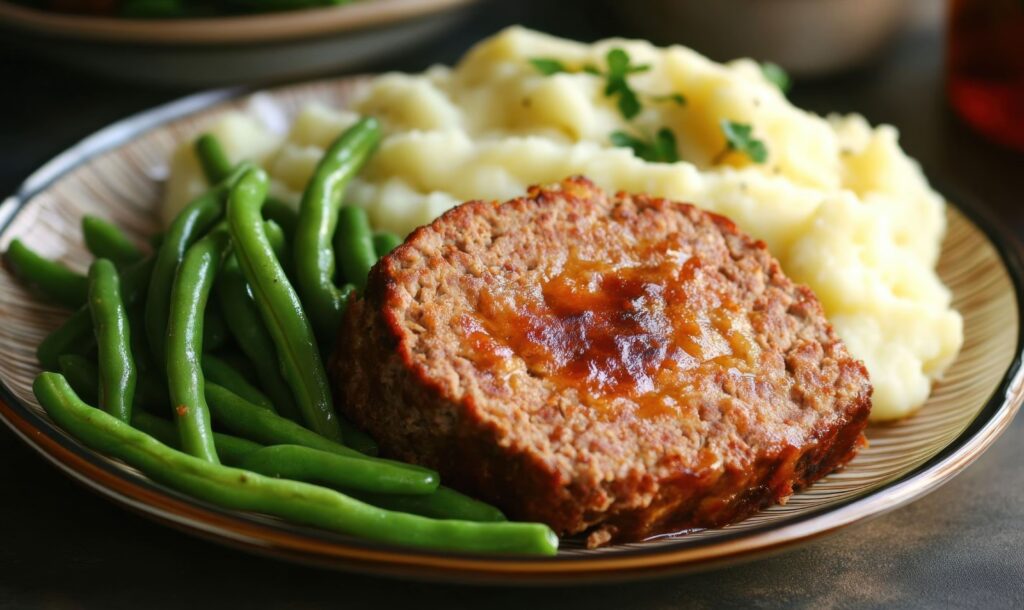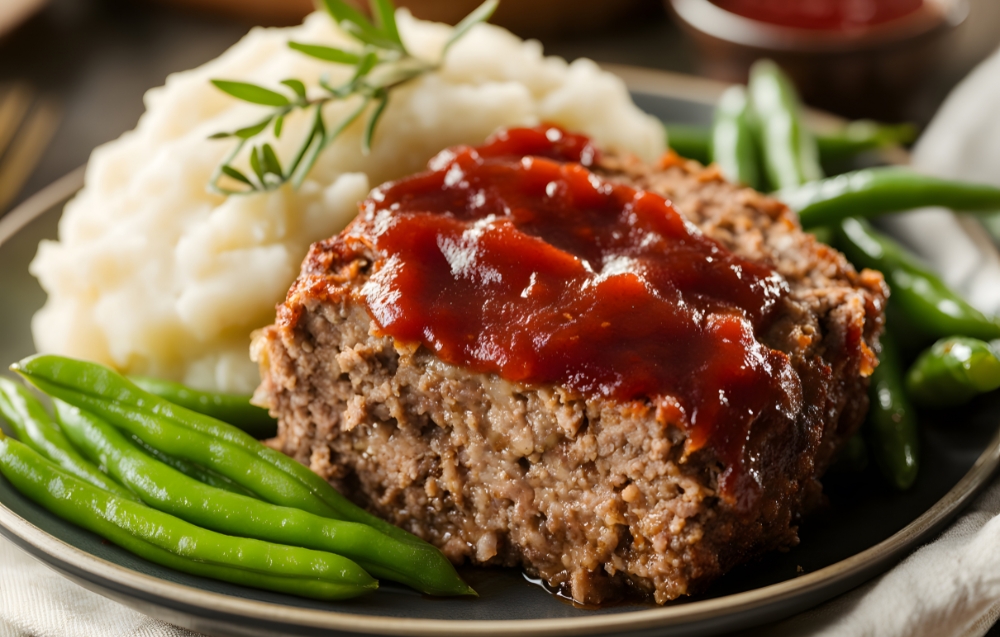Ah, meatloaf. The humble dish that’s been the star of family dinners, potlucks, and comfort food cravings for generations. But here’s the million-dollar question: should meatloaf have ketchup or gravy? It’s a debate that’s sparked countless kitchen arguments, divided households, and even inspired passionate foodie think pieces. Whether you’re Team Ketchup or Team Gravy, one thing’s for sure—this isn’t just about toppings. It’s about tradition, flavor, and the soul of a dish that’s as versatile as it is delicious.
In this article, we’re diving deep into the great meatloaf topping debate. We’ll explore the history of meatloaf, the role of toppings, and the pros and cons of ketchup vs. gravy. Plus, we’ll tackle common problems (like burnt ketchup or soggy gravy) and offer solutions to help you perfect your meatloaf game. By the end, you’ll have all the tools you need to decide—ketchup, gravy, or something entirely different. Let’s get started!
Table of Contents
Introduction: The Great Meatloaf Topping Controversy
Picture this: It’s Sunday night, and the aroma of freshly baked meatloaf fills the air. You’re hungry, your family’s gathered around the table, and then it happens—someone asks, “Are we having ketchup or gravy with this?” Suddenly, the room splits into two camps. One side swears by the sweet, tangy glaze of ketchup, while the other insists that only rich, savory gravy will do. Sound familiar?
The truth is, the ketchup vs. gravy debate isn’t just about personal preference. It’s about how toppings can transform a dish. Ketchup brings a caramelized, slightly sweet crust to the meatloaf, while gravy adds a luxurious, velvety layer of flavor. But which one is better? Well, that depends on who you ask—and what you’re in the mood for.
“Meatloaf is like a blank canvas. The toppings are where you get to express your creativity and personality.” – A Passionate Home Cook
In this article, we’ll explore both sides of the argument, dig into the history of meatloaf, and even throw in some creative topping ideas for those who want to think outside the box. Whether you’re a ketchup loyalist or a gravy enthusiast, there’s something here for everyone. And if you’re looking for more inspiration, check out our Best Italian Meatloaf Recipe for a delicious twist on this classic dish.
The History of Meatloaf: A Comfort Food Staple
Before we dive into the ketchup vs. gravy debate, let’s take a step back and look at where meatloaf came from. Spoiler alert: it’s been around a lot longer than you might think.
Origins of Meatloaf: From Ancient Times to Modern Kitchens
Believe it or not, meatloaf has ancient roots. The concept of mixing ground meat with other ingredients dates back to the Roman Empire, where a dish called “isicia omentata” was made with minced meat, bread, and wine (though we’ll skip the wine for this discussion). Fast forward to medieval Europe, and you’ll find similar dishes made with whatever ingredients were on hand.
But the meatloaf we know and love today? That’s a distinctly American invention. During the Great Depression, meatloaf became a popular way to stretch expensive ingredients like beef by combining them with cheaper fillers like breadcrumbs, oats, or vegetables. It was hearty, affordable, and could feed a crowd—perfect for tough times.
How Meatloaf Became an American Classic
By the mid-20th century, meatloaf had cemented its place in American cuisine. It was a staple of home cooking, diner menus, and even school cafeterias. Part of its appeal was its versatility. You could customize it with different meats, spices, and, of course, toppings. And that’s where the ketchup vs. gravy debate comes in.
“Meatloaf is the ultimate comfort food because it’s familiar, filling, and endlessly adaptable.” – A Food Historian
Today, meatloaf is more than just a dish—it’s a cultural icon. It’s the food of family gatherings, nostalgic memories, and yes, heated debates about toppings. But no matter how you slice it (pun intended), meatloaf’s enduring popularity is a testament to its simplicity and heartiness. If you’re curious about other comfort food classics, don’t miss our Sweet Potato Bread recipe—it’s the perfect side dish for any meal.

The Role of Toppings in Meatloaf: Ketchup vs. Gravy
Now that we’ve covered the history, let’s get to the heart of the matter: toppings. Why do they matter so much, and what do ketchup and gravy bring to the table?
Why Toppings Matter: Flavor, Moisture, and Presentation
Toppings aren’t just an afterthought—they’re an integral part of the meatloaf experience. They add flavor, moisture, and visual appeal. A well-chosen topping can elevate a good meatloaf to greatness, while a poorly chosen one can leave it dry, bland, or unappetizing.
Think of toppings as the finishing touch, like the icing on a cake or the sauce on a pasta dish. They tie everything together and make the dish feel complete. But with so many options out there, how do you choose? Let’s break it down.
Ketchup on Meatloaf: A Sweet and Tangy Tradition
Ketchup is the classic choice for many meatloaf lovers, and for good reason. Its sweet, tangy flavor pairs perfectly with the savory richness of the meat. When baked on top of the loaf, it forms a sticky, caramelized crust that’s downright irresistible.
But ketchup isn’t just about taste—it’s also about nostalgia. For many of us, ketchup-topped meatloaf is the version we grew up eating. It’s comfort food at its finest, evoking memories of family dinners and home-cooked meals. If you’re looking for a unique twist, try our Meatloaf Sauce Recipe, which combines ketchup with a few secret ingredients for an extra flavor boost.
Gravy on Meatloaf: A Rich and Savory Alternative
On the other side of the debate, we have gravy. Unlike ketchup, which is applied before baking, gravy is typically served on top of the finished meatloaf. It’s rich, savory, and adds a luxurious touch to the dish.
Gravy lovers argue that it complements the meatloaf’s flavor without overpowering it. It also keeps the loaf moist, which is especially important if you’re using leaner meats like turkey or chicken. Plus, there’s something undeniably comforting about a generous pour of gravy over a slice of meatloaf. For tips on keeping your meatloaf perfectly moist, check out our guide on The Secret To Moist Meatloaf.
The Case for Ketchup: Pros and Cons
Let’s take a closer look at ketchup as a meatloaf topping. What makes it so popular, and what are the potential downsides?
Advantages of Using Ketchup on Meatloaf
- Flavor Boost: Ketchup’s sweet and tangy profile adds depth to the meatloaf’s flavor.
- Caramelized Crust: When baked, ketchup forms a deliciously sticky glaze that’s hard to resist.
- Ease of Use: It’s a simple, no-fuss topping that requires minimal preparation.
Common Problems with Ketchup Toppings and How to Fix Them
- Problem: Ketchup Burns or Overcaramelizes
Solution: Lower the oven temperature and cover the meatloaf with foil during the last 15 minutes of baking. - Problem: Ketchup Overpowers the Meatloaf
Solution: Mix ketchup with other ingredients like mustard or brown sugar to balance the flavor.
The Case for Gravy: Pros and Cons
Now, let’s turn our attention to gravy, the rich and savory counterpart to ketchup. Gravy lovers swear by its ability to elevate meatloaf to a whole new level of comfort food perfection. But like ketchup, gravy has its own set of pros and cons. Let’s break it down.
Advantages of Using Gravy on Meatloaf
- Rich Flavor: Gravy adds a deep, savory flavor that complements the meatloaf without overpowering it. It’s like a warm hug for your taste buds.
- Moisture Boost: Gravy keeps the meatloaf moist, especially if you’re using leaner meats like turkey or chicken. No one likes a dry meatloaf!
- Versatility: You can customize gravy with herbs, spices, or even a splash of Worcestershire sauce to match your meatloaf’s flavor profile.
If you’re new to making gravy or want to perfect your technique, check out this guide on how to make perfect gravy. It’s a game-changer for gravy enthusiasts!
Common Problems with Gravy Toppings and How to Fix Them
- Problem: Gravy Makes Meatloaf Too Soggy
Solution: Serve the gravy on the side instead of pouring it directly over the meatloaf. This way, you can control how much you use. - Problem: Gravy Separates or Becomes Lumpy
Solution: Whisk constantly while cooking, and use a slurry (cornstarch mixed with water) to thicken the gravy smoothly. - Problem: Gravy Lacks Flavor
Solution: Enhance the flavor with pan drippings, herbs, or a splash of soy sauce for umami depth.
Gravy is all about balance, and once you master it, you’ll understand why so many people are Team Gravy. But if you’re curious about the science behind why certain toppings work so well, this article on the science behind caramelization is a fascinating read.
Regional Variations: How Different Cultures Top Their Meatloaf
Meatloaf isn’t just an American dish—it’s a global phenomenon with countless regional twists. Let’s take a culinary trip around the world to see how different cultures top their meatloaf.
Ketchup-Dominated Regions: The Midwest and Southern US
In the Midwest and Southern United States, ketchup reigns supreme. It’s often mixed with brown sugar or mustard to create a sweet-and-tangy glaze that caramelizes beautifully in the oven. This style of meatloaf is hearty, comforting, and deeply rooted in tradition.
Gravy-Loving Regions: The UK and Parts of Europe
Across the pond, gravy is the go-to topping for meatloaf (or its close cousin, meatloaf-like dishes). In the UK, for example, a rich onion gravy is often served alongside meatloaf or shepherd’s pie. It’s a classic combination that’s both filling and flavorful.
Unique Meatloaf Toppings from Around the World
- Italy: Think beyond ketchup and gravy with a tomato-based marinara sauce or a sprinkle of Parmesan cheese.
- Mexico: Spice things up with a smoky chipotle sauce or a drizzle of crema.
- Asia: Try a teriyaki glaze or a sweet-and-sour sauce for an unexpected twist.
The Science Behind Meatloaf Toppings: What Works Best?
Ever wonder why ketchup and gravy are such popular choices for meatloaf? It all comes down to science—flavor chemistry, to be exact. Let’s geek out for a moment and explore why these toppings work so well.
How Ketchup Enhances Flavor and Texture
Ketchup is a powerhouse of flavor. Its sweetness comes from sugar, while its tanginess comes from vinegar and tomatoes. When baked, the sugars in ketchup caramelize, creating a sticky, slightly crispy crust that adds both flavor and texture to the meatloaf.
But ketchup isn’t just about taste—it’s also about chemistry. The acidity in ketchup helps tenderize the meat, making it juicier and more flavorful.
How Gravy Adds Moisture and Richness
Gravy, on the other hand, is all about moisture and richness. It’s typically made from pan drippings, broth, and a thickening agent like flour or cornstarch. The result is a velvety sauce that coats the meatloaf, keeping it moist and adding layers of savory flavor.
The key to great gravy is balance. Too thin, and it’s watery; too thick, and it’s gloppy. But when done right, gravy can transform a simple meatloaf into a gourmet meal.
Common Problems with Meatloaf Toppings and Their Solutions
Even the most experienced cooks run into issues with meatloaf toppings from time to time. Here are some common problems and how to fix them.
Problem: Ketchup Burns or Overcaramelizes
Solution: Lower the oven temperature and cover the meatloaf with foil during the last 15 minutes of baking. This prevents the ketchup from burning while still allowing it to caramelize.
Problem: Gravy Makes Meatloaf Too Soggy
Solution: Serve the gravy on the side instead of pouring it directly over the meatloaf. This way, you can control how much you use and keep the meatloaf from getting soggy.
Problem: Toppings Overpower the Meatloaf Flavor
Solution: Balance the flavors by mixing ketchup with mustard or brown sugar, or by adding herbs and spices to your gravy. The goal is to complement the meatloaf, not overshadow it.
Creative Meatloaf Topping Ideas Beyond Ketchup and Gravy
If you’re tired of the same old ketchup vs. gravy debate, why not shake things up with some creative topping ideas? Meatloaf is a blank canvas, and there’s no rule that says you have to stick to tradition. Here are a few fun and flavorful alternatives to try:
- BBQ Sauce: Swap out ketchup for smoky, tangy BBQ sauce. It adds a bold, Southern-inspired twist to your meatloaf.
- Cheese Toppings: Add a layer of shredded cheddar, mozzarella, or even blue cheese to the top of your meatloaf during the last few minutes of baking. The result? A gooey, melty masterpiece.
- Herb-Infused Glazes: Mix honey, Dijon mustard, and fresh herbs like rosemary or thyme for a sophisticated glaze that’s bursting with flavor.
These creative toppings prove that meatloaf doesn’t have to be boring. Experiment with different flavors and find your new favorite combination!
Step-by-Step Guide: Perfecting Your Meatloaf Toppings
No matter which topping you choose, the key to success is in the execution. Here’s a step-by-step guide to help you get it right every time.
How to Apply Ketchup for the Best Results
- Timing is Everything: Spread the ketchup (or ketchup-based glaze) over the meatloaf during the last 20-30 minutes of baking. This prevents it from burning while still allowing it to caramelize.
- Mix It Up: Combine ketchup with other ingredients like mustard, brown sugar, or Worcestershire sauce for a more complex flavor.
- Cover if Needed: If the ketchup starts to darken too quickly, cover the meatloaf with foil to protect it.
How to Make the Perfect Gravy for Meatloaf
- Use Pan Drippings: After baking your meatloaf, use the drippings from the pan as the base for your gravy. This adds incredible depth of flavor.
- Whisk Constantly: To avoid lumps, whisk the gravy constantly as it thickens. A slurry of cornstarch and water can help achieve a smooth consistency.
- Season Well: Don’t forget to taste and adjust the seasoning. A pinch of salt, pepper, or herbs can make all the difference.
Frequently Asked Questions About Meatloaf Toppings
Let’s tackle some common questions about meatloaf toppings to clear up any confusion.
Can You Use Both Ketchup and Gravy on Meatloaf?
Absolutely! There’s no rule against combining the two. Try baking the meatloaf with a ketchup glaze and serving it with a side of gravy for the best of both worlds.
What’s the Best Way to Store Leftover Meatloaf with Toppings?
Store leftover meatloaf in an airtight container in the refrigerator for up to 3-4 days. If the meatloaf is topped with gravy, store the gravy separately to prevent sogginess.
Are There Healthier Alternatives to Ketchup and Gravy?
Yes! Try using a homemade tomato sauce with less sugar, or opt for a light gravy made with low-sodium broth and a cornstarch thickener. You can also experiment with yogurt-based sauces or pesto for a fresh twist.
Conclusion: Ketchup, Gravy, or Something Else? The Choice Is Yours
At the end of the day, the great meatloaf topping debate comes down to personal preference. Ketchup brings sweetness and nostalgia, while gravy adds richness and comfort. But why stop there? With so many creative options out there, the possibilities are endless.
Whether you’re a die-hard ketchup fan, a gravy enthusiast, or an adventurous cook looking to try something new, the most important thing is to enjoy the process. After all, meatloaf is about more than just food—it’s about tradition, creativity, and bringing people together. So go ahead, experiment, and make your meatloaf uniquely yours. Happy cooking!

